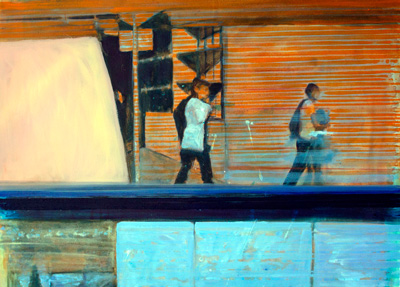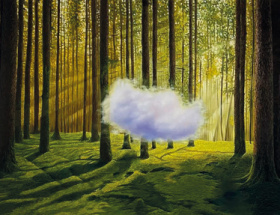Abstract to the Top
By Estela Ferrer
Each trace, therefore, is the real experience with its history
You do not illustrate: it is the perception of its own achievement
Cy Twombly
The landscape has quite a few cultivators within the circuit of contemporary Cuban art. It has been receiving even more acceptance among very young artists who fully involve in experimentation. However, some of these emerging artists still prefer figuration or expressionism. In the painting Alejandro Jurado Morales (Havana, 1986) the creative impulse is born from experience, but transformed into spaces and music, which inevitably arrive or depart. He has studied the legacy of lyric abstraction and post-impressionism in the ways of solving the strokes. It is there where he feels more at ease, amid the color spots and the recognizable motifs deprived of realism, in the own freedom and expansion that enlivens nature as a whole.
Hence the possibility of discovering the influence of Riopelle or Hartung in the initial canvases, but that slowly leads to Turner’s romanticism and Kiefer’s uniqueness. I guess it is also a form of verifying the transformation in the image of his work: from a more aggressive painting fond of dripping and a high contrast palette to a quieter one with predominance of natural motifs. In these paintings, the apparent opposition of the color stains reveals the organic duality that extends from the central zones, as well as the multiple stains that punctuate the colored surfaces he boldly employs to dig into daily life, history or the simple beauty of an ordinary day’s end.
Alejandro Jurado’ work focuses on the possibilities of expression of the landscape to introduce planes of living experience, employing flowers as main metaphor of his visual discourse. Everything comes together: physical time, the wishes left behind throughout life and the national history experienced by the body. Each painting becomes a reflexive fragment of an expanded composition. That composition is the very existence and its finiteness, expressed in each one of its aspects: the private, the social and the political.
From the very beginning, in the most acid period, the titles already had an important value. Later they became more direct, and for that reason it was easier for the viewer to discover the codes handled by the artist behind the transparencies and dissimilar layers of color. Sometimes the titles are given in Roman numbers because they start by being studies, but the idea finds a good finishing, becomes more corporal and transforms into an independent work. Perhaps one of the places that most pieces has inspired him is the Topes de Collantes landscape because of its incomparable and unrepeatable vegetation, but in the paintings it remains an enigma since there is no direct reference to it in any of them.
His present work precisely moves between the closed nature and the flirting with the borders of figuration and abstraction. He has learned each one of the legacies of abstractionists and romantics, of foreigners and locals. A sort of charming rural scene with all its colors and specificities enlivens this visual essay, which is nothing but a testament in images of a vital experience marked by the alleged innocence of bunches of flowers faithful to their creator and to their time.



